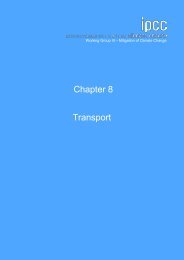Rural Transport and Agriculture Fact Sheet
recap_factsheet_2_-_final_-_english
recap_factsheet_2_-_final_-_english
You also want an ePaper? Increase the reach of your titles
YUMPU automatically turns print PDFs into web optimized ePapers that Google loves.
Reducing Costs of <strong>Rural</strong> <strong>Transport</strong> <strong>and</strong> <strong>Agriculture</strong><br />
Well functioning agricultural markets are<br />
essential for rural growth <strong>and</strong> poverty<br />
reduction. Most rural households are<br />
connected with markets, as sellers of<br />
produce <strong>and</strong>/or buyers of food, <strong>and</strong><br />
access to reliable produce markets<br />
enables farming households to<br />
commercialise their production systems<br />
<strong>and</strong> increase their farm incomes. 6<br />
Smallholder food production is undermined<br />
by high transaction costs, low market power<br />
<strong>and</strong> limited access to finance services<br />
<strong>and</strong> infrastructure. 7 Multiple transactions<br />
between different wholesalers <strong>and</strong> retailers<br />
can increase the price difference between<br />
farmer <strong>and</strong> retailer with little real value<br />
added, as shown in the following illustration<br />
of the Ghanaian maize market.<br />
One way of increasing incomes is to engage<br />
in direct contract-farming with supermarkets<br />
or food processing factories. Selling directly to<br />
these organisations cuts out intermediaries<br />
<strong>and</strong> gives farmers greater certainty over<br />
returns, <strong>and</strong> can also help to reduce transport<br />
costs <strong>and</strong> help increase farm gate prices.<br />
Additional services such as cleaning,<br />
processing <strong>and</strong> packaging can also increase<br />
value of agricultural products.<br />
In most developing countries, dem<strong>and</strong> for<br />
agricultural products is increasing rapidly,<br />
driven largely by increasing incomes of urban<br />
consumers. The rapid emergence of<br />
supermarkets has spurred the establishment<br />
of modern value chains, particularly for<br />
high-value food products. Restructured<br />
markets can offer new opportunities for<br />
smallholders, but also pose higher entry costs<br />
<strong>and</strong> risks of marginalisation. 8<br />
<strong>Transport</strong> <strong>and</strong> Marketing<br />
Associations <strong>and</strong> Cartels<br />
Cartels limit competition by controlling<br />
the production <strong>and</strong> distribution<br />
agricultural products, thus creating a<br />
gap between costs <strong>and</strong> prices.<br />
Operators in cartel-dominated markets<br />
are able to achieve high profits despite<br />
low utilisation of their vehicle fleets,<br />
though operators find it hard to break<br />
into these markets. In East Africa,<br />
where the trucking environment is<br />
competitive, cartels have a limited<br />
presence, <strong>and</strong> major corridors in<br />
Southern Africa are even more<br />
efficient, mainly due to a deregulated<br />
transport market. 12<br />
Layers of intermediaries characterize Ghana’s maize markets<br />
$ per 100 kilograms, 1998<br />
17.3<br />
Farmgate<br />
price<br />
1.7 0.6 0.3 1.1 0.3<br />
H<strong>and</strong>ling &<br />
other costs<br />
<strong>Transport</strong><br />
Commission<br />
<strong>and</strong> mktg fee<br />
Storage,<br />
interest, losses<br />
Wholesale<br />
agent fee<br />
1.5 22.8 0.8<br />
Wholesale profit<br />
Technician<br />
wholesale price<br />
H<strong>and</strong>ling,<br />
mktg fee, others<br />
1.7 0.9 0.7 27.0 1.2 0.9<br />
<strong>Transport</strong><br />
Storage, interest,<br />
losses<br />
Wholesale profit<br />
Accra wholesale<br />
price<br />
<strong>Transport</strong>, h<strong>and</strong>ling,<br />
mktg fee,<br />
Storage, interest,<br />
losses<br />
1.9 31.0<br />
Retailer profit<br />
Accra retail price<br />
Reference: World Bank World Development Report 2008, <strong>Agriculture</strong> for Development<br />
Case Study: High-Value Food Crops in Thail<strong>and</strong><br />
Swift Co., Ltd. is a Thai company <strong>and</strong> one of Southeast Asia’s<br />
leading exporters of quality vegetables <strong>and</strong> fruits, such as<br />
mangosteen, galangal, <strong>and</strong> lemon grass. The company exports<br />
more than 200 tons of fresh produce each month to global<br />
retail markets.<br />
Swift’s contract-farming model provides a guaranteed market for<br />
growers <strong>and</strong> cuts out inefficient logistics <strong>and</strong> profit-taking along a<br />
multi-tiered production chain. Collection stations are set up near<br />
every growing area to cut transport costs <strong>and</strong> minimise damage to<br />
produce, <strong>and</strong> daily harvests are combined into lots for delivery to<br />
packing houses via temperature-controlled trucks. 6<br />
Agricultural <strong>Transport</strong> Costs in Africa <strong>and</strong> Asia<br />
Several major comparative studies<br />
indicate that freight transport tariffs have<br />
been up to six times higher in Africa than<br />
in Asia, for comparable journeys. Although<br />
many of these studies relate to<br />
long-distance travel, the same patterns of<br />
inefficiency were also found for<br />
short-distance rural transport<br />
movements. 9 Earlier studies emphasised<br />
high input costs <strong>and</strong> low utilisation in Africa,<br />
<strong>and</strong> a recent study emphasises high transport<br />
profits in Africa due to cartels, operator<br />
associations <strong>and</strong> freight queuing systems. 10,11<br />
High transport costs <strong>and</strong> inefficient<br />
marketing directly influence farmer <strong>and</strong><br />
retail prices. A comparative study found<br />
that average food grain producer prices as<br />
a percentage of final market prices<br />
ranged from 75 to 90% in Asia, <strong>and</strong> only<br />
from 30 to 60% in Africa. <strong>Transport</strong><br />
costs accounted for 27.5% of average<br />
market prices in Kenya <strong>and</strong> Malawi<br />
compared with 13.8% in Bangladesh<br />
<strong>and</strong> Indonesia. 12<br />
3.9%<br />
0.6%<br />
45%<br />
11%<br />
27.5%<br />
12.6%<br />
Components of<br />
Final Market Price,<br />
Kenya/ Malawi<br />
80%<br />
13.8%<br />
4%<br />
1.6%<br />
Components of<br />
Final Market Price,<br />
Bangladesh/ Indonesia<br />
Percentage received<br />
by producers<br />
<strong>Transport</strong> <strong>and</strong><br />
associated costs<br />
Profit<br />
Transaction costs<br />
Taxes



